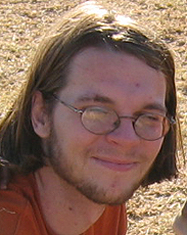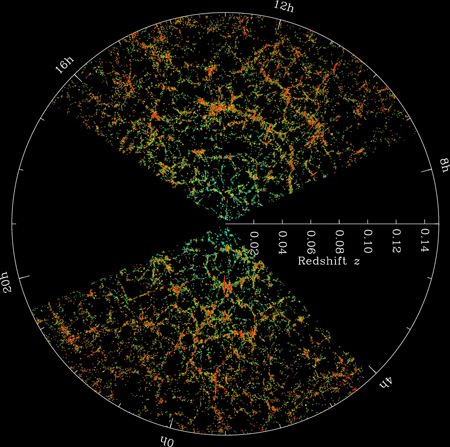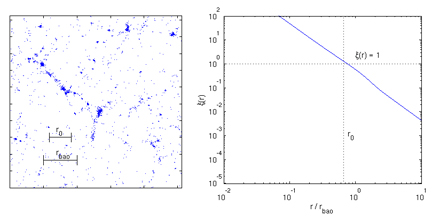Simulations improve characterization of cosmology’s ‘standard ruler’
Columbus, OH (July 12, 2011) – Ohio State University researchers are leveraging powerful supercomputers to investigate one of the key observational probes of “dark energy,” the mysterious energy form that is causing the expansion of the universe to accelerate over time.
 |
|
Chris Orban
|
The OSU project, led by Chris Orban, a graduate research fellow in physics at Ohio State’s Center for Cosmology and Astro-Particle Physics, focuses on simulations created on Ohio Supercomputer Center (OSC) systems to simplify and better characterize a subtle dark matter clustering feature. The new model allows cosmologists to gain a more accurate understanding of certain aspects of large-scale structure, such as the effect of the expansion of the universe on the growth of density fluctuations.
“Knowing how the dark matter ‘reacts’ to the expansion of the universe is crucial for learning the most about dark energy and dark matter from large astronomical surveys like the Sloan Digital Sky Survey, of which OSU is a collaborating member,” said Orban. “In particular, there is a subtle clustering feature seen in this data set called ‘Baryon Acoustic Oscillations’ (BAO), which turns out to be very useful for constraining cosmological parameters like the equation of state of dark energy.”
The oscillations come from fluctuations in the distribution of hot plasma in the early universe; researchers can identify this feature by measuring the cosmic microwave background.
“The BAO signature gets imprinted on the dark matter very early on, but the feature changes over cosmic time, potentially biasing its use as a cosmological tool,” Orban explained. “It’s a complicated non-linear problem, and physicists are very fond of simplifying complicated problems to gain a more in-depth understanding. This is exactly what we did for the first time, in our paper, using N-body simulations.”
“For current state-of-the-art astronomical surveys, the main non-linear effects that we investigate in the paper are negligible compared to other sources of error, but next-generation surveys will need to be far more sophisticated in this regard,” said Orban’s academic advisor, David Weinberg, Ph.D., who is a professor of astronomy at OSU and the project scientist for the Sloan Survey. “This places the utmost importance on making reliable and precise predictions for these non-linear effects, a task which cosmological N-body simulations are in many ways well-suited to do.”
 |
|
Produced by the Sloan Digital Sky Survey, this three-dimensional map of the distribution of galaxies shows Earth at the center, and represents each galaxy with a single point (credit: M. Blanton and SDSS). Large astronomical surveys, such as SDSS, rely upon a model of Baryon Acoustic Oscillations to provide a cosmological “standard ruler” for determining length scale. Ohio State University’s Chris Orban and David Weinberg, Ph.D., have employed Ohio Supercomputer Center resources to simplify and better characterize that BAO model. |
 |
| Snapshots from cosmological simulations (left) performed on Ohio Supercomputer Center systems and a plot of the clustering of dark matter on different scales (right). [Click for animation.] Orban and Weinberg are studying the evolution of the Baryon Acoustic Oscillations standard ruler using a new cosmological model that simplifies the non-linear dynamics that affect the BAO bump feature. |
Since early 2009, Orban and Weinberg have employed nearly 200,000 processor-hours of computational time on the OSC’s flagship Glenn Cluster and eight terabytes of storage space on its Mass Storage Environment. The Glenn Cluster offers researchers more than 9,600 Opteron cores, 24 terabytes of memory and a peak computational capability of 75 teraflops – which translates to 75 trillion calculations per second.
For software, the researchers employed the state-of-the-art Gadget-2 N-body code to calculate the trajectories of more than a hundred million particles, and set the initial conditions using the 2LPT code developed by their collaborators at New York University.
“This research project represents a fantastic conjunction of people and disciplines,” observed Ashok Krishnamurthy, co-executive director of OSC. “It brought together professionals in the fields of physics, astronomy and computational science to produce impressive results that might not otherwise have come together for many years. OSC is proud to have contributed to these achievements.”
Orban and Weinberg authored a paper on this research, “Self-similar Bumps and Wiggles: Isolating the Evolution of the BAO Peak with Power-law Initial Conditions,” which is slated for publication in the journal Physical Review D. The project is supported by funding from the National Science Foundation.
“We’re both pretty proud of the final product, which we’ve been working on for about two and a half years,” Orban said. “Our production runs represent by far the largest set of cosmological simulations ever performed at The Ohio State University.
The Ohio Supercomputer Center (OSC) is a catalytic partner of Ohio universities and industries, providing a reliable high performance computing and high performance networking infrastructure for a diverse statewide/regional community including education, academic research, industry, and state government. Funded by the Ohio Board of Regents, OSC promotes and stimulates computational research and education in order to act as a key enabler for the state's aspirations in advanced technology, information systems, and advanced industries. For more, visit www.osc.edu.
The Center for Cosmology and Astro-Particle Physics (CCAPP) at The Ohio State University builds upon the unique environment between the OSU Departments of Astronomy and Physics, to pursue research at the interface of cosmology, astrophysics, and high energy physics. The Center’s primary objective is to create a world-leading interdisciplinary research center focused on the fundamental questions of “What is the Universe made of?” and “How did it evolve?” through research initiatives that include dark energy, "multi-messenger" astro-particle physics, dark matter, and the birth and growth of the Universe. For more, visit ccapp.osu.edu.
Funding for the Sloan Digital Sky Survey (SDSS) has been provided by the Alfred P. Sloan Foundation, the Participating Institutions, the National Science Foundation, and the U.S. Department of Energy. The SDSS-III web site is http://www.sdss3.org/. SDSS-III is managed by the Astrophysical Research Consortium for the Participating Institutions of the SDSS-III Collaboration including the University of Arizona, the Brazilian Participation Group, Brookhaven National Laboratory, University of Cambridge, University of Florida, the French Participation Group, the German Participation Group, the Instituto de Astrofisica de Canarias, the Michigan State/Notre Dame/JINA Participation Group, Johns Hopkins University, Lawrence Berkeley National Laboratory, Max Planck Institute for Astrophysics, New Mexico State University, New York University, Ohio State University, Pennsylvania State University, University of Portsmouth, Princeton University, the Spanish Participation Group, University of Tokyo, University of Utah, Vanderbilt University, University of Virginia, University of Washington, and Yale University.